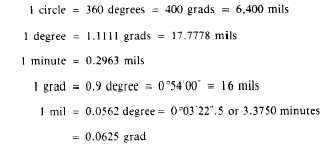Sexagesimal or North American System
In the sexagesimal or North American system,
the circle is divided into 360 equal parts known
as DEGREES of arc, each degree into 60 equal
parts known as MINUTES of arc, and each
minute into 60 equal parts known as SECONDS
of arc. As an example, angles in this system
are written as 263047’16’’.48 which is read as
“two hundred sixty-three degrees, forty-seven
minutes, and sixteen point four eight seconds of
arc. ” In the United States, this is the most
commonly used system of angular measurement.
MORE UNITS OF MEASUREMENT
Aside from the units of measurement
discussed above, the EA must also deal with
other units of measurement, such as TIME,
TEMPERATURE, PRESSURE, and so forth.
He must use exact time in computing problems
in astronomy and some laboratory works. He
must be able to apply temperature corrections to
his tape readings. He must also evaluate the
effect of atmospheric pressure at different
elevations and get involved in some other
types of measure that will be discussed in the
following paragraphs.
Centisimal or Metric System
Time Measurement
In the centisimal or metric system, the full
circle is divided into four quadrants, and each
quadrant is divided into 100 equal parts known
as GRADS or GRADES. Each grad is further
divided into decimal parts. As an example, angles
in this system are written as 376g.7289, or
376g72´89" which is read as “three hundred
seventy-six point seven two eight nine grads,” or
as “three hundred seventy-six grads, seventy-two
centisimal minutes, and eighty-nine centisimal
seconds. ”
Mil System
In the mil system, the circle is divided into
6,400 equal parts known as MILS. The mil is
divided into decimal parts. As an example, angles
in this system are written as 1728.49 roils, which
is read as “one thousand seven hundred twenty-
eight point four nine mils.” This system is used
principally by the artillery people. The significance
of this unit of angular measure is the fact that 1
mil is the angle that will subtend 1 yd at a range
of 1,000 yd.
The relationship among values in the three
systems of angular measure are as follows:
For practical purposes in everyday affairs and
in surveying, the measurement of time intervals
is of great concern. The time used in everyday life
is known as STANDARD TIME and is based on
the mean apparent revolution of the sun around
the earth because of the earth’s rotation on its
axis. Standard time is used in surveying to regulate
the normal day’s operations. But, when it is
necessary to observe the sun or the stars to
determine the azimuth of a line or the position
of a point on the earth’s surface, the surveyor uses
three other kinds of time. They are APPARENT
(true) SOLAR TIME, CIVIL (mean solar) TIME,
and SIDEREAL (star) TIME. You will learn more
about these different times when you study the
chapter on “Geodesy and Field Astronomy” in
Engineering Aid 1 & C.
In all four kinds of time, the basic units of
measure are the YEAR, DAY, HOUR, MINUTE,
and SECOND of time. The duration of any one
of these units is not the same for all kinds of time.
For example, the sidereal day is approximately 4
min shorter than a standard- or civil-time day.
In the practice of surveying, it is customary
to say, or write, the time of day as the number
of hours, minutes, and seconds since midnight.
Then the recorded time would appear, for
example, as 16h37*52S.71 which is read as
“sixteen hours, thirty-seven minutes, and fifty-
two point seven one seconds of time.”
Units of time measure are sometimes used to
designate the sizes of angles. The longitude of a
point on the earth’s surface is often expressed in
this manner. The relationship between the units
1-30



